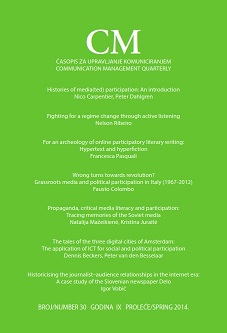For an Archaeology of Online Participatory Literary Writing: Hypertext and Hyperfiction
For an Archaeology of Online Participatory Literary Writing: Hypertext and Hyperfiction
Author(s): Francesca PasqualiSubject(s): History, Media studies, Fiction, Studies of Literature, Social Informatics
Published by: Fakultet političkih nauka Univerziteta u Beogradu
Keywords: hypertext; collaborative fiction; literary theory; history of computing; media archaeology; cultural participation;
Summary/Abstract: This article analyzes one of the roots of contemporary online participatory writing practices within the literary field, focusing on an object that had its theoretical heyday twenty years ago: hypertextual fiction. Invented in the sixties by social informatics visionary Ted Nelson, the word “hypertext” gained academic attention in the humanities in the early nineties with the works (among others) of George P. Landow, Paul Delany, David Bolter and Stuart Moulthrop. In 1992, in his review of Michal Joyce’s Afternoon (still credited as one of the first pieces of hypertext fiction) Robert Coover (1992) wrote in The New York Times Book Review: “much of the novel’s alleged power is embedded in the line […] Through print’s long history, there have been countless strategies to counter the line’s power […] but true freedom from the tyranny of the line is perceived as only really possible now at last with the advent of hypertext, written and read on the computer, where the line in fact does not exist unless one invents and implants it in the text”. Since then, hypertext started to be defined as an artifact empowering the reader to subvert the linear text and the author’s authority, and thus, within a post-structural and postmodern theoretical framework, deconstructing and subverting the very roots of power tout court. By addressing hypertext theory (a mixture of history of textual forms, of reading practices, and of technologies of memory, semiotics, poststructuralist and feminist theory, etc.) and tracing the influences of postmodern literature and the literary avant-gardes on hypertext fiction, the article will thus investigate both the construction of hypertext as a participatory “cultural object” – in Wendy Griswold’s (1994) terms – and the legacy of that theoretical debate and those artistic practices in contemporary reflections on online collaborative literary writing.
Journal: CM Komunikacija i mediji
- Issue Year: 9/2014
- Issue No: 30
- Page Range: 35-54
- Page Count: 20
- Language: English

